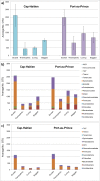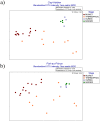Bacterial community structure transformed after thermophilically composting human waste in Haiti
- PMID: 28570610
- PMCID: PMC5453478
- DOI: 10.1371/journal.pone.0177626
Bacterial community structure transformed after thermophilically composting human waste in Haiti
Abstract
Recycling human waste for beneficial use has been practiced for millennia. Aerobic (thermophilic) composting of sewage sludge has been shown to reduce populations of opportunistically pathogenic bacteria and to inactivate both Ascaris eggs and culturable Escherichia coli in raw waste, but there is still a question about the fate of most fecal bacteria when raw material is composted directly. This study undertook a comprehensive microbial community analysis of composting material at various stages collected over 6 months at two composting facilities in Haiti. The fecal microbiota signal was monitored using a high-density DNA microarray (PhyloChip). Thermophilic composting altered the bacterial community structure of the starting material. Typical fecal bacteria classified in the following groups were present in at least half the starting material samples, yet were reduced below detection in finished compost: Prevotella and Erysipelotrichaceae (100% reduction of initial presence), Ruminococcaceae (98-99%), Lachnospiraceae (83-94%, primarily unclassified taxa remained), Escherichia and Shigella (100%). Opportunistic pathogens were reduced below the level of detection in the final product with the exception of Clostridium tetani, which could have survived in a spore state or been reintroduced late in the outdoor maturation process. Conversely, thermotolerant or thermophilic Actinomycetes and Firmicutes (e.g., Thermobifida, Bacillus, Geobacillus) typically found in compost increased substantially during the thermophilic stage. This community DNA-based assessment of the fate of human fecal microbiota during thermophilic composting will help optimize this process as a sanitation solution in areas where infrastructure and resources are limited.
Conflict of interest statement
Figures




References
-
- King F. Farmers of Forty Centuries or Permanent Agriculture in China, Korea and Japan Emmaus: Rodale Press; 1911.
-
- Kramer S, Preneta N, Kilbride a. Thermophilic composting of human wastes in uncertain urban environments: a case study from Haiti. 36th WEDC Int Conf. 2013;2011: 1–6.
-
- Ishii K, Takii S. Comparison of microbial communities in four different composting processes as evaluated by denaturing gradient gel electrophoresis analysis. JApplMicrobiol. 2003;95: 109–119. - PubMed
-
- Pourcher AM, Morand P, Picard-Bonnaud F, Billaudel S, Monpoeho S, Federighi M, et al. Decrease of enteric micro-organisms from rural sewage sludge during their composting in straw mixture. J Appl Microbiol. 2005;99: 528–539. doi: 10.1111/j.1365-2672.2005.02642.x - DOI - PubMed
-
- Danon M, Franke-Whittle IH, Insam H, Chen Y, Hadar Y. Molecular analysis of bacterial community succession during prolonged compost curing. FEMS Microbiol Ecol. 2008;65: 133–144. doi: 10.1111/j.1574-6941.2008.00506.x - DOI - PubMed
MeSH terms
Substances
Grants and funding
LinkOut - more resources
Full Text Sources
Other Literature Sources

